Westminster School
Westminster School is a historic public school in Westminster, London, England, within the precincts of Westminster Abbey and beside the Houses of Parliament. It can be traced to a charity school founded by Westminster Benedictine monks before the Norman Conquest in 1066, documented by the Croyland Chronicle and a charter of King Offa. Its unbroken existence is clear from the early 14th century.[10] Boys are admitted to Under School at the age of seven and by examination to the senior school at 13, girls to the Sixth Form at 16.[11] The school has some 750 pupils; about a quarter are mainly weekday boarders, free to go home after Saturday morning school.[12] The school motto Dat Deus Incrementum refers to 1 Corinthians 3:6: "I planted the seed and Apollos watered it, but God made it grow"[13] The school was one of nine examined by the Clarendon Commission of 1861.[14] and reformed by the Public Schools Acts Westminster is one of the few UK schools to have educated several Nobel laureates: Edgar Adrian (Nobel Prize for Physiology in 1932), Sir Andrew Huxley (same award in 1963) and Sir Richard Stone (Nobel Prize in Economics in 1984).
| Westminster School | |
|---|---|
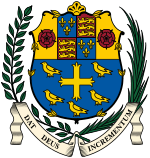 | |
| Address | |
Little Dean's Yard | |
| Coordinates | 51.4984°N 0.1284°W |
| Information | |
| Type | Public school Independent day and boarding school |
| Motto | Latin: Dat Deus Incrementum (God Gives the Increase) |
| Religious affiliation(s) | Church of England[3] |
| Established | Earliest records date from the 14th century, refounded in 1560 |
| Founder | Henry VIII (1541) Elizabeth I (1560 – refoundation) |
| Local authority | City of Westminster |
| Department for Education URN | 101162 Tables |
| Chairman of Governors | John Hall, Dean of Westminster[4][5][6] |
| Head Master | Patrick Derham[7] |
| Staff | 105 |
| Gender | Boys Coeducational (Sixth Form)[8][9] |
| Age | 13 (boys), 16 (girls) to 18 |
| Enrolment | 747 |
| Houses | Busby's College Ashburnham Dryden's Grant's Hakluyt's Liddell's Milne's Purcell's Rigaud's Wren's |
| Colour(s) | Pink |
| Publication | The Elizabethan |
| Former pupils | Old Westminsters |
| Website | www |
History

The earliest records of a school at Westminster date back to the 1370s and are held in Westminster Abbey's Muniment Room,[15] with parts of the buildings now used by the school dating back to the 10th century Anglo-Saxon Abbey at Westminster.[16] In their annual accounts the school cites their origin as lying in a decree of Pope Alexander III in 1179[17] though the evidence for this is unclear.
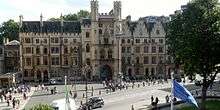
In 1540, Henry VIII ordered the dissolution of the monasteries in England, including that of the powerful Abbots of Westminster, but personally ensured the School's survival by his royal charter.[18] The Royal College of St. Peter carried on with forty "King's Scholars" financed from the royal purse. By this point Westminster School had certainly become a public school (i.e. a school available to members of the paying public, rather than the private tuition arranged by the nobility). During Mary I's brief reign the Abbey was reinstated as a Roman Catholic monastery, but the school continued.
Elizabeth I refounded the school in 1560,[19] with new statutes to select 40 Queen's Scholars from boys who had already attended the school for a year.[20] Queen Elizabeth frequently visited her scholars, although she never signed the statutes nor endowed her scholarships, and 1560 is now generally taken as the date that the school was "founded".
Elizabeth I appointed William Camden[21] as headmaster, and he is the only layman known to have held the position until 1937.[22] It was Dr Busby,[23][24] himself an Old Westminster, who established the reputation of the school for several hundred years, as much by his classical learning as for his ruthless discipline by the birch, immortalised in Pope's Dunciad. Busby prayed publicly Up School[25] for the safety of the Crown, on the very day of Charles I's execution, and then locked the boys inside to prevent their going to watch the spectacle a few hundred yards away. Regardless of politics, he thrashed Royalist and Puritan boys alike without fear or favour. Busby also took part in Oliver Cromwell's funeral procession in 1658, when a Westminster schoolboy, Robert Uvedale, succeeded in snatching the "Majesty Scutcheon" (white satin banner) draped on the coffin, which is now held in the library[26] (it was given to the school by his family two hundred years later). Busby remained in office throughout the Civil War and the Commonwealth, when the school was governed by Parliamentary Commissioners, and well into the Restoration.
In 1679, a group of scholars killed a bailiff, ostensibly in defence of the Abbey's traditional right of sanctuary, but possibly because the man was trying to arrest a consort of the boys. Dr Busby obtained a royal pardon for his scholars from Charles II and added the cost to the school bills.
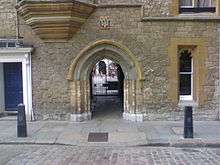
Until the 19th century, the curriculum was predominantly made up of Latin and Greek, and all taught up School.[27] The Westminster boys were uncontrolled outside school hours and notoriously unruly about town, but the proximity of the school to the Palace of Westminster meant that politicians were well aware of the boys' exploits. After the Public Schools Act 1868, in response to the Clarendon Commission[28] on the financial and other malpractices at nine pre-eminent public schools, the school began to approach its modern form. It was legally separated from the Abbey, although the organisations remain close and the Dean of Westminster Abbey is ex officio the Chairman of the Governors. There followed a scandalous public and parliamentary dispute lasting a further 25 years, to settle the transfer of the properties from the Canons of the Abbey to the school. School statutes have been made by Order in Council of Queen Elizabeth II. The Dean of Christ Church, Oxford, and the Master of Trinity College, Cambridge, are ex officio members of the school's governing body.[29]
Unusually among public schools, Westminster did not adopt most of the broader changes associated with the Victorian ethos of Thomas Arnold, such as the emphasis on team over individual spirit, and the school retained much of its distinctive character. Despite many pressures, including evacuation and the destruction of the school roof during the Blitz, the school refused to move out of the city, unlike other schools such as Charterhouse and St. Paul's, and remains in its central London location.
Westminster Under School was formed in 1943[30] in the evacuated school buildings in Westminster, as a distinct preparatory school for day pupils between the ages of eight to 13 (now seven to 13). Only the separation is new: for example, in the 18th century, Edward Gibbon attended Westminster from the age of 11 and Jeremy Bentham from the age of eight.[31] The Under School has since moved to Vincent Square,[32] overlooking the school's playing fields. Its current Master is Mark O'Donnell.
In 1967, the first female pupil was admitted to the school, with girls becoming full members of the school from 1973 onwards.[33] In 1981, a single-sex boarding house, Purcell's, was created for girls. In 1997 the school expanded further with the creation of a new day house, Milne's at 5a, Dean's Yard.
In 2005 the school was one of fifty leading independent schools guilty of running a cartel, exposed by The Times, which had allowed them to collaborate in uncompetitive fees for thousands of customers.[34][35] Mrs Jean Scott, the head of the Independent Schools Council, said that independent schools had always been exempt from anti-cartel rules applied to business, were following a long-established procedure in sharing the information with each other, and that they were unaware of the change to the law (on which they had not been consulted). She wrote to John Vickers, the OFT director-general, saying, "They are not a group of businessmen meeting behind closed doors to fix the price of their products to the disadvantage of the consumer. They are schools that have quite openly continued to follow a long-established practice because they were unaware that the law had changed.".[36] However, each school agreed to pay a nominal penalty of £10,000 and ex-gratia payments totalling £3 million into a trust designed to benefit pupils who attended the schools during the period in respect of which fee information was shared.[37][38][39]
In 2007, the school responded to an invitation to become the sponsor of Pimlico School, which was due to be rebuilt as an academy, but decided not to go ahead after Westminster City Council developed its plans. In 2013 the school collaborated with the Harris Federation to set up a selective, mixed, sixth form academy, with entrance priority given to those from disadvantaged backgrounds. Harris Westminster Sixth Form opened nearby in 2014, and pupils of the academy share some lessons and facilities of the school.
In 2010 the school and the abbey celebrated the 450th anniversary of the granting of their royal charter and Elizabeth I's refoundation of the school in 1560. Queen Elizabeth II with the Duke of Edinburgh unveiled a controversial statue in Little Dean's Yard of the queen's namesake Elizabeth I, the nominal foundress of the School, by Old Westminster sculptor Matthew Spender.[40] The head of the statue came off in May 2016 after a Sixth Former (a pupil in Year 12) tried to climb on the statue. The statue's head has since been replaced.
In May 2013, the school was criticised for staging an auction involving the selling of internships to fund bursaries, resulting in adverse coverage in the press.[41]
In December 2017, the school announced plans to open six schools in China, working with Hong Kong educational group HKMETG, with the first opening in Chengdu in 2020.[42][43] Revenue generated by the deal will be used to support bursary funds at the existing school, and follows similar moves by Harrow School, Malvern School, Wellington College and Dulwich College. The school was criticized in the media and by its pupils for its decision to teach the Chinese national curriculum as opposed to an international curriculum normally taught by international schools.[44] Steve Tsang, director of the China Institute at SOAS London, was quoted in the Financial Times as saying: “I think they have no idea what they’re dealing with [...] If you set up a school in China, they will have a party secretary superintending the whole school and the party secretary will be responsible for political education”.[45] The school responded by arguing that it would exercise "soft power" over the teaching, and would also teach an international curriculum for students aged 16–18.[46] The issue was re-opened when the Times published an article, quoting Professor Edward Vickers of Kyushu University, accusing the school (and Kings College School who have similar plans) of "helping Chinese teach propaganda".[47]
The school is located primarily in the precincts of the former medieval monastery of Westminster Abbey,[48] its main buildings surrounding its private square Little Dean's Yard (known as 'Yard'), off Dean's Yard, where Church House, the headquarters of the Church of England, is situated,[49] along with some of the houses, the common room, the humanities building Weston's, and College Hall.
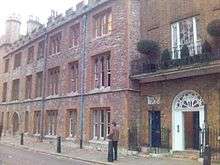
Immediately outside the abbey precincts on Great College Street is Sutcliff's (named after the tuck shop in the building in the 19th century), where Geography, Art,[50] Theology, Philosophy and Classics (Latin and Ancient Greek) are taught. The Robert Hooke Science Centre[51] is further away, just off Smith Square.[52] As part of an expansion programme funded by donations and a legacy from A. A. Milne,[53] the school has acquired the nearby Millicent Fawcett Hall for Drama and Theatre Studies lessons and performances;[54][55] the Manoukian Centre for Music lessons[56][57][58] (both timetabled and private) and recitals; and the Weston Building at 3 Dean's Yard.[59][60] It also often uses St John's, Smith Square as a venue for major musical concerts.
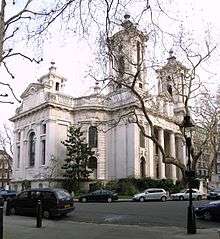
College Garden, to the East of Little Dean's Yard, is believed to be the oldest garden in England, under continuous cultivation for around a millennium.[61] Just beyond rises the Victoria Tower of the Houses of Parliament; the Queen's Scholars have special rights of access to the House of Commons. To the North, the Dark Cloister leads straight to the Abbey, which serves as the School Chapel.[62]
The playing fields are half a mile away at Vincent Square,[63] which Dean Vincent created for the school by hiring a horse and plough to carve 10 acres (40,000 m2) out of the open Tothill Fields. The boathouse is now some way from the school at Putney,[63] where it is also used for the Oxford and Cambridge boat race; but the school's First Eight still returns annually to exercise its traditional right to land at Black Rod Steps of the Palace of Westminster.
In 2011, the school agreed to buy a 999-year lease for the Lawrence Hall, London from The Royal Horticultural Society.[64] This listed Art-Deco building, adjacent to the school's playing fields at Vincent Square, has been converted into a Sports Centre. It provides space for an array of activities, including climbing, martial arts, fencing, rowing, table tennis, badminton, netball, indoor football and indoor cricket.[65] In 2012 the school took possession of St Edward's House, which was the last Anglican monastery in London.[66] Located on the corner of Great College Street and Tufton Street the building now houses Purcell's, a Boarding House for girls and a Day House for boys, as well as a small Chapel and Refectory.[67] Westminster Under School has also been enlarged by the addition of a building on Douglas Street which provides an Art Studio, IT Suite and Dining Hall.[68]
Westminster was the 13th most expensive HMC day school and 10th most expensive HMC boarding school in the UK in 2014/5[69] It achieved the highest percentage of students accepted by Oxbridge colleges over the period 2002–2006,[70] and was ranked as the best boys' school in the country in terms of the GCSE results in 2017.[71]
Notable buildings
Westminster School, situated in the middle of the UNESCO World Heritage Site of Westminster Abbey, St. Margaret's, and the Palace of Westminster, has several buildings notable for unique qualities, age, and history.
'College Hall', the 14th-century abbot's state dining hall, is one of the oldest and finest examples of medieval refectory in existence, and is still in use for its original purpose every day in term-time; outside of term it reverts to the dean, as the abbot's successor.[72] Queen Elizabeth Woodville took sanctuary here in 1483 with five daughters and her son Richard of Shrewsbury, Duke of York, but failed to save him from his fate as one of the Princes in the Tower. In the 1560s, Elizabeth I several times came to see her scholars act their Latin plays on a stage in front of the attractive Elizabethan gallery, which may have been first erected especially for the purpose.[73][74]
'College', now shared between the three Houses of College, Dryden's and Wren's, is a dressed stone building overlooking College Garden,[75] the former monastery's Infirmary garden which is still the property of the Collegiate Church of Westminster Abbey. College dates from 1729, and was designed by the Earl of Burlington based on earlier designs from Sir Christopher Wren (himself an Old Westminster).
'School', originally built in the 1090s as the monks' dormitory, is the school's main hall, used for Latin Prayers (a weekly assembly with prayers in the Westminster-dialect of Latin),[76] exams, and large concerts, plays and the like. From 1599 it was used to teach all the pupils, the Upper and Lower Schools being separated by a curtain hung from a 16th-century pig iron bar, which remains the largest piece of pig iron in the world. The school gateway was also designed by the Earl of Burlington, and are engraved with the names of many pupils who used to hire a stonemason for the purpose.[77] The panelling "up School" is similarly, but officially, painted with the coats of arms of many former pupils. The original shell-shaped apse at the north end of school gave its name to the shell forms taught there and the corresponding classes at many other public schools. The current shell displays a Latin epigram on the rebuilding of School, with the acrostic Semper Eadem, Elizabeth I's motto. The classroom door to the right of the Shell was recovered from the notorious Star Chamber at its demolition but was destroyed during the Blitz.

The building lies directly on top of the Westminster Abbey museum in the Norman Undercroft, and ends at the start of the Pyx Chamber.
Both School and College had their roofs destroyed during the Blitz by incendiary bombs in 1941. The buildings were re-opened by George VI in 1950.[78]
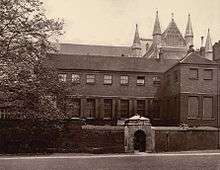
Ashburnham House houses the library[79] and the Mathematics Department,[80] and until 2005 accommodated the Economics, English and History of Art departments as well. Ashburnham House may have been built by Inigo Jones or his pupil John Webb around the time of the Restoration, as a London seat for the family who became the Earls of Ashburnham. It incorporates remains of the mediaeval Prior's House, and its garden is the site of the monks' refectory and some of the earliest sittings of the House of Commons. In 1731 when Ashburnham housed the King's and Cottonian libraries, which form the basis of the British Library,[81] there was a disastrous fire, and many of the books and manuscripts still show the marks.[82] After the Public Schools Act 1868 there was a scandalous parliamentary and legal battle between the Dean and Chapter of Westminster Abbey and the School, until the School eventually obtained Ashburnham House under the Act for £4,000. The dispute was reported in The Times, and it was suggested by Thomas Wise, Secretary of The Society for the Protection of Ancient Buildings that the property was "in danger of being pulled down or of being virtually destroyed by being converted into a boarding-house in connexion with Westminster School" adding that the "house is admirably suited for a residence for the Dean or one of the Canons, and is totally unfitted for a school or a boarding house".[83] The school responded writing that "The Chapter themselves have in past years greatly altered and disfigured Ashburnham-house. It had originally two wings; one was destroyed and never restored. About 1848 the roof was taken off, a story added, and a dome in the ceiling of the drawing-room demolished, the external elevation being ruined. The house now has no beauty externally, and hardly any features of interest internally, except the staircase, which in any case would be preserved".[84] On 28 November William Morris also became involved in the campaign, writing a letter to the editor of The Daily News.[85] In the event the school demolished the adjacent building, Turle's House and renovated sections of the east wing, but left the staircase and drawing room untouched.[86] During the Second World War, the library was used for military purposes, and as an American officers' club, The Churchill Club.
Customs

The 'Greaze' has been held 'up School' (in the School Hall) on Shrove Tuesdays since at least 1753.[87] The head cook ceremoniously tosses a horsehair-reinforced pancake over a high bar, which was used from the 16th century to curtain off the Under School from the Great School. Members of the school fight for the pancake for one minute, watched over by the Dean of Westminster Abbey (as Chairman of the Governors), the head master, the upper years groups of the School[88] and distinguished or even occasionally royal visitors. The pupil who gets the largest weight is awarded a gold sovereign (promptly redeemed for use next year), and the Dean begs a half-holiday for the whole School. Weighing scales are on hand in the event of a dispute. A cook who failed to get the 'pancake' over the bar after three attempts would formerly have been "booked", or pelted with Latin primers, although that tradition has long lapsed.[89][90]
The privilege of being the first commoners to acclaim each new sovereign at their coronation in Westminster Abbey is reserved for the Queen's (or King's) Scholars. Their shouts of "Vivat Regina/Rex" ("Long Live the Queen/King") are incorporated into the coronation anthem I was glad.[91] The tradition dates back to the coronation of King James II.[92]
Despite the formal separation from the abbey,[93] the school remains Anglican, with services in the abbey attended by the entire school at least twice a week, and many other voluntary-attendance services of worship. The school was expressly exempted by the Act of Uniformity to allow it to continue saying Latin prayers despite the Reformation. Every Wednesday there is an assembly Up School known as Latin Prayers, which opens with the headmaster leading all members of the school in chanting prayers in Latin, followed by notices in English. The school's unique pronunciation of formal Latin is known as 'Westminster Latin', and descends from medieval English scholastic pronunciation: Queen Elizabeth I, who spoke fluent Latin, commanded that Latin was not to be said "in the monkish fashion", a significant warning upon loyalties between Church and State. The School commemorates its benefactors every year with a service in Westminster Abbey in Latin in which the Captain of the Queen's Scholars lays a wreath of pink roses on the tomb of Elizabeth I: the service alternates between 'Little Commem' which is held in Henry VII's Chapel and involves just the Queen's Scholars and the much larger 'Big Commem' to which the whole school community is invited.[94]
Since the monastic Christmas revels of medieval times, Latin plays have been presented by the Scholars, with a prologue and witty epilogue on contemporary events. Annual plays, "either tragedy or comedy", were required by the school statutes in 1560, and some early plays were acted in College Hall before Elizabeth I and her whole Council. However, in a more prudish age Queen Victoria did not accompany Prince Albert and the Prince of Wales to the play, and recorded in her diary that it was "very Improper". Today, the play is put on less frequently, any members of the school may take part, and the Master of the Queen's Scholars gives the Latin prologue. The 1938 play caused a diplomatic incident with the German ambassador withdrawing offended by the words 'Magna Germania' figuring in extenso on a map of Europe displayed.
The Queen's Scholars have privileged access to the House of Commons gallery, said to be a compromise recorded in the Standing Orders of the House in the 19th century, to stop the boys from climbing into the Palace over the roofs.
There is a Westminster jargon little known to the general populace:
Years 9,10,11,12,13 are called Fifth Form, Lower Shell, Upper Shell, Sixth Form and Remove, respectively.
Green is Dean's Yard.
Yard is Little Dean's Yard.
School is the main school hall where Latin Prayers, exams and major plays and talks take place.
Sanctuary is the area outside the Great West Door of the Abbey off Broad Sanctuary.
Fields is Vincent Sqaure.
The preposition 'up' is used to mean 'at' or 'towards' (hence up School). At my house (boarding/day) and home can be differentiated thus, up House meaning at School and at my house meaning at home.
Entry
There are four main points of entry for pupils:
- For the Under School, at ages 7, 8, and 11, judged by a combination of internal exam and interview.[95]
- For the Lower School, at age 13, judged by either Common Entrance, a standardised, national set of exams for entrance to independent schools,[96] for standard entry; or the Challenge, an internal set of exams for scholarship entry; as well as interview.
- For the Upper School, at age 16, judged by subject-specific exams and interviews and conditional upon GCSE results. This is the only point of entry for girls, and only a handful of boys join at this point each year.
As well as the normally eight annual Queen's Scholarships, which pay 80 per cent of boarding fees, there are Honorary Scholarships for boys who pass the Challenge and could have been scholars but do not want to board, and Exhibitions for a few candidates who were close to scholarship standard – however, neither of these carry any fee reduction or other financial benefits. Notably, Stephen Hawking was entered for the Challenge in 1952, but fell ill on the day of the Challenge examination. His parents were unable to pay the fees without the financial aid of a scholarship, and so he did not attend the school.
Houses
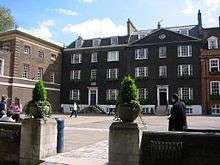
The school is split into 11 houses, some of which are day houses (they only admit day pupils, who go home after school), the others being boarding houses with a mix of boarders and day pupils. CC is the exception to this - all QSS must board. Each house has a Housemaster, a teacher who is responsible for the house, the pupils in it and their welfare, and a Head of House, a pupil in the Remove, nominated by the Housemaster. The role of the Head of House largely consists of assisting the Housemaster in organising activities such as house competitions, for which the Head of House might draw up teams. Further to these positions, each day house (a house which only admits day pupils) has an Assistant Housemaster, and each boarding house has a Resident Tutor. The houses are named after people connected to the house or school in various ways – mainly prominent Old Westminsters but also former Head Masters and Housemasters. Grant's is the oldest house for pupils other than scholars, not only of Westminster but of any public school.
Houses are a focus for pastoral care and social and sporting activities, as well as accommodation for boarders. All the day houses are mixed-sex, and all houses admit girls; RR is the only boarding house not to admit girls as boarders and PP does not admit boys as boarders.[97]
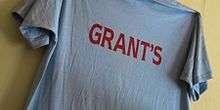
| House | Abbr. | Founded | Named after | Colours | Pupils | ||
|---|---|---|---|---|---|---|---|
| Boarding | Day | ||||||
| College | CC | 1560 | n/a | Dark green | Mixed[98] | None | |
| Grant's | GG | 1750 | The "mothers" Grant – landladies who owned the property and put up boys in the days before boarding existed, when the School only accommodated Scholars; the oldest house in any of the Public Schools. | ■ | Maroon on light blue | Mixed | Mixed |
| Rigaud's | RR | pre-1896 (rebuilt) | Stephen Jordan Rigaud - former schoolmaster | ■ | Black on orange (Tie uses orange on black) | Boys | Mixed |
| Busby's | BB | 1925 | Richard Busby - former Head Master | ■ | Dark blue on maroon | Mixed | Mixed |
| Liddell's | LL | 1956 | Henry Liddell - former Head Master | ■ | Blue on yellow (ties are yellow on black or yellow and silver on black) | Mixed | Mixed |
| Purcell's[lower-alpha 1] | PP | 1981 | Henry Purcell - former Organist of Westminster Abbey | ■ | White on purple | Girls | Boys |
| Ashburnham | AHH | 1881 | The Earls of Ashburnham whose London house is now part of the School | ■ | Light blue on dark blue | None | Mixed |
| Wren's | WW | 1948 | Christopher Wren OW | ■ | Pink on black (Blue and Maroon used on ties) | ||
| Dryden's | DD | 1976 | John Dryden OW | ■ | Silver on red (Tie uses separated silver and red stripes on dark blue) | ||
| Hakluyt's | HH | 1987 | Richard Hakluyt OW[99] | ■ | Yellow on blue | ||
| Milne's | MM | 1997 | A. A. Milne OW | ■ | Black on orange (Tie uses Red and Yellow) | ||
All Queen's Scholars, both boys and girls, are required to board in College (unless under exceptional circumstances). Wren's was formerly known as Homeboarders and Dryden's as Dale's. Before it was rebuilt, Rigaud's was known as Clapham's and Best's.
Sport ("Station")
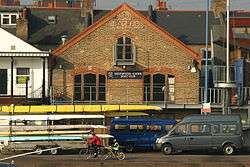
The school has three Eton Fives courts, located behind Ashburnham House. The school frequently fields pupils as national entries in international competitions in rowing, or "Water", and fencing.
Westminster School Boat Club is one of the oldest rowing clubs in the world, located on the River Thames. The Oxford University Boat Club uses Westminster's boat house at Putney as its HQ for the annual Oxford and Cambridge boat race on the Thames. The boathouse was remodelled in 1997 and won a Wandsworth design award in 1999.[100] The school's colour is pink; Westminster rowers raced Eton College for the right to wear the colour.[101] One story goes that, at one annual Eton-Westminster rowing race, both crews arrived wearing pink, which was fashionable at the time. The Eton crew bought some light-blue ribbon (which later became the standard Eton colours) to differentiate themselves, but the Westminster crew won the race and the right to wear pink in perpetuity. The premier Leander Club at Henley, founded in London by a number of Old Westminster rowers, later adopted it, although they call the colour cerise.[102] The only problems arise when racing against Abingdon School, whose team also wears pink.
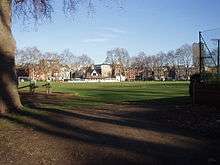
Since 1810, when the headmaster, William Vincent, fenced off and ordered the ploughing of the waste marshlands known as Tothill Fields for use by the school, which were being threatened by London's urban sprawl, the school's main sports ground has been nearby at Vincent Square,[103][104] which football and cricket on the main area and tennis and netball on the courts; it also hosts a playground for Westminster Under School. At 13 acres, it is the largest private, open green space in Central London, despite this, it is not large enough for all the pupils doing these sports to use simultaneously (the three football pitches and typically one smaller practise pitch become one main cricket square and several smaller practise squares for the cricket season). Therefore, the school hires and owns other sporting facilities near the school. These include the oldest boating club in the world, an astroturf ground in Battersea, and the Queen Mother Sports Centre, home to a variety of sports. "Green" (Dean's Yard) is also used, as are the two school gyms (one in the Abbey Cloisters and one in the Weston Building) and the three Eton Fives courts in Ashburnham Garden, the garden behind Ashburnham House.
Westminster played in the first school cricket match against Charterhouse School in 1794[105] and from 1796 played cricket against Eton.[106]
| Wikisource has original text related to this article: |
Westminster has an historic joint claim to a major role in the development of Association Football,.[107] During the 1840s at both Westminster and Charterhouse, pupils' surroundings meant they were confined to playing their football in the cloisters,[108] making the rough and tumble of the handling game that was developing at other schools such as Rugby impossible, and necessitating a new code of rules. During the formulation of the rules of Association Football in the 1860s, representatives of Westminster School and Charterhouse also pushed for a passing game, in particular rules that allowed forward passing ("passing on"). Other schools (in particular Eton College, Harrow, and Shrewsbury School) favoured a dribbling game with a tight off-side rule. By 1867 the Football Association had chosen in favour of the Westminster and Charterhouse game and adopted an off-side rule that permitted forward passing.[109][110] The modern forward-passing game was a direct consequence of Westminster and Charterhouse football.
Headmasters
- Since 2014 Patrick Derham
- 2005–2014 Dr Stephen Spurr
- 1998–2005 Tristram Jones-Parry
- 1986–1998 David Summerscale
- 1970–1986 Dr John Malcolm Rae
- 1957–1970 John Dudley Carleton
- 1950–1957 Walter Hamilton
- 1937–1950 John Traill Christie
- 1919–1936 Harold Costley-White
- 1901–1919 Dr James Gow
- 1883–1901 William Gunion Rutherford
- 1855–1883 Charles Broderick Scott
- 1846–1855 Henry George Liddell
- 1828–1846 Richard Williamson
- 1819–1828 Edmund Goodenough
- 1815–1819 William Page
- 1803-1814 William Carey
- 1802 John Wingfield
- 1788–1802 William Vincent
- 1764–1788 Samuel Smith
- 1764 John Hinchliffe
- 1753–1764 William Markham
- 1733–1753 John Nicoll
- 1711–1733 Robert Freind
- 1695–1711 Thomas Knipe
- 1639–1695 Dr Richard Busby
- 1621–1639 Lambert Osbaldeston (jointly with Wilson until 1626)
- 1610–1626 John Wilson
- 1598–1610 Richard Ireland
- 1593–1597 William Camden
- 1572–1592 Edward Grant
- 1570–1572 Francis Howlyn
- 1564–1570 Thomas Browne
- 1563 John Randall
- 1562 Robert Rolle
- 1557 John Passey
- 1555–1556 Nicholas Udall
- 1543–1555 Alexander Nowell
- 1540 John Adams
Other notable masters
- Nick Bevan (rowing coach, later headmaster of Shiplake College)
Controversies
Between 2001 and 2004, the school was one of fifty independent schools involved in the Independent school fee fixing scandal in the United Kingdom. It was subsequently found guilty of operating a fee-fixing cartel by the Office of Fair Trading. The commission argued that until 2000, the practice had been legal, and that the commission had not been aware of the change to the law.[111]
Notable alumni
The following people were educated at Westminster, of about 900 listed in the Oxford Dictionary of National Biography:
- Richard Hakluyt (1553–1616), writer[112]
- Thomas Braddock (1556-1607), clergyman and translator[113]
- Ben Jonson (1573–1637), poet and dramatist[114]
- Arthur Dee (1579–1651), alchemist and royal physician
- George Herbert (1593–1633), public orator and poet[115]
- John Dryden (1631–1700), poet and playwright[116]
- John Locke (1632–1704), philosopher[117]
- Sir Christopher Wren (1632–1723), architect and scientist, co-founder of the Royal Society[118]
- Robert Hooke FRS (1635–1703), scientist[119]
- Henry Purcell (1659–1695), composer
- Joseph Thurston (1704–1732), poet admired by Alexander Pope[120]
- Charles Wesley (1707–1788), Methodist preacher and writer of over 6,000 hymns[121]
- Augustus Henry Fitzroy, 3rd Duke of Grafton (1735–1811), Prime Minister
- Edward Gibbon FRS (1737–1794), historian[122]
- Charles O'Hara (1740 – 25 February 1802), British military officer in the Seven Years' War, American War of Independence, and French Revolutionary War, later Governor of Gibraltar
- Jeremy Bentham (1748–1832), lawyer, eccentric and philosopher[123]
- Charles Cotesworth Pinckney (1746–1825), ADC to Washington 1777, defeated by Jefferson in 1804 in contest for Presidency
- Thomas Pinckney (1750–1828), American soldier, politician, and diplomat
- Robert Southey (1774–1843), poet, historian and biographer[124]
- Matthew Lewis (1775–1818), novelist and dramatist[125]
- FitzRoy Somerset, 1st Baron Raglan (1788–1855), lost his right arm at Waterloo, C-in-C in the Crimea who is honoured with a statue in Dean's Yard
- John Russell, 1st Earl Russell (1792–1878), Prime Minister
- Augustus Short (11 June 1802 – 5 October 1883), the first Anglican bishop of Adelaide, South Australia
- A. A. Milne (1882–1956, QS), author and journalist[126]
- Oliver Lyttelton, 1st Viscount Chandos (1893–1972), Cabinet Minister during World War II, chairman of the National Theatre Board
- Hossein Ala' (1882–1964), former Prime Minister of Iran
- Sir Adrian Boult (1889–1983), conductor
- Edgar Adrian, 1st Baron Adrian (1889–1977) Nobel prize winner
- Charles William Anderson Scott (1903–1946), pioneer aviator
- Sir John Gielgud (1904–2000, GG), actor and director[127]
- Charles Harvard Gibbs-Smith (1909–1981), historian[128]
- Kim Philby (1912–1988), high-ranking member of British intelligence, one of the Cambridge Five and NKVD/KGB double agent
- Sir Norman Parkinson (1913–1990), portrait and fashion photographer
- Richard Stone (1913–1991), winner of the Nobel Prize in Economics[129]
- Sir Andrew Huxley (1917–2012), Nobel prizewinning physiologist
- Sir Peter Ustinov (1921–2004), actor, writer, director and raconteur[130]
- Tony Benn (1925–2014), politician[131]
- Peter Brook (born 1925, LL 1937–1938), theatre director
- Nigel Lawson (born 1932, WW 1945–1950), former Chancellor of the Exchequer, father of Nigella Lawson
- Simon Gray (1936–2008, WW 1949–1954), playwright and diarist[132]
- Jonathan Fenby (born 1942, LL 1956–1960), journalist, author and former Editor of The Observer and South China Morning Post
- Martyn Poliakoff CBE, FRS (born 1947), Foreign Secretary and Vice-President of the Royal Society and narrator of The Periodic Table of Videos[133]
- Andrew Lloyd Webber (born 1948, QS 1960–1965), composer and producer[134]
- Stephen Poliakoff (born 1952, WW 1966–1970), director, playwright and television dramatist[135]
- Chris Huhne (born 1954), disgraced Liberal Democrat politician
- Dominic Grieve (born 1956), former attorney-general and pro-European politician
- Shane MacGowan (born 1957, AHH 1972–1973), musician
- Adam Boulton (born 1959), journalist, broadcaster and author
- Andrew Graham-Dixon (born 1960), art critic and writer
- Edward St Aubyn (born 1960), author and journalist[136]
- Timothy Winter (born 1960), Shaykh Zayed Lecturer in Islamic Studies, Faculty of Divinity, Cambridge University
- David Heyman (born 1961), film producer[137][138][139]
- Alexander Beard (born 1963), arts administrator
- Matt Frei (born 1963, RR 1978–1981), broadcaster[140]
- Ian Bostridge (born 1964), classical tenor
- Gavin Rossdale (born 1965), musician, songwriter, lead singer with rock band Bush
- Michael Sherwood (born 1965), banker
- Lucasta Miller (born 1966), writer and critic
- Helena Bonham Carter (born 1966, LL 1982–1984), actress[141]
- Jason Kouchak (born 1967), pianist and composer
- Noreena Hertz (born 1967, CC 1983–85), economist and campaigner
- Nick Clegg (born 1967, LL), Liberal Democrat leader, MP for Sheffield Hallam, former Deputy Prime Minister[142]
- James Robbins (1968–1972, GG), broadcaster
- Ruth Kelly (born 1968, DD 1984–86), cabinet minister[143]
- Marcel Theroux (born 1968), novelist and broadcaster[144]
- Joe Cornish (born 1968), broadcaster, director and screenwriter
- Adam Buxton (born 1969), comedian
- Lucy Walker (born 1970), documentary film-maker[145]
- Louis Theroux (born 1970), broadcaster
- Jonathan Yeo (born 1970), artist
- Dido Armstrong (born 1971, WW, 1987–1989), British musician under the name "Dido"
- Polly Arnold (born 1972) OBE FRS FRSE FRSC Professor of Chemistry at the University of Edinburgh[146]
- Martha Lane Fox (born 1973), head of Digital Public Services[147]
- James Reynolds (born 1974), BBC Beijing Correspondent
- Conrad Shawcross (born 1977), artist
- Pinny Grylls (born 1978, HH 1994–1996), documentary film-maker
- Benjamin Yeoh (born 1978), playwright
- Alexander Shelley (born 1979), conductor
- Michael Penniman (born 1983), musician
- Jack Farthing (born 1985), actor
- Alfred Enoch (born 1988), actor
- Blondey McCoy (born 1997), fashion designer and model

Victoria Cross holders
Six pupils of Westminster have been awarded the Victoria Cross:
- Edmund Henry Lenon VC (1830–1893, at Westminster June 1851–1855)
- William George Hawtry Bankes VC (1836–1858) (at Westminster April 1850–1856)
- Nevill Maskelyne Smyth VC (1868–1941, at Westminster June 1882–1885). He served in the First World War, later Sir Nevill Maskelyne Smyth VC, KCB, Croix de Guerre (Belgium), Legion d'Honneur (France)
- Arthur Martin-Leake VC and Bar (1874–1953) (at Westminster June 1888–1891), one of only three to receive twice[148]
- William Hew Clark-Kennedy VC, CMG, DSO & Bar (1879–1961, at Westminster June 1893–1896)
- Richard Wakeford VC. (1921–1972, at Westminster June 1934–1940)
See also
- List of the oldest schools in the world
- Old Westminsters F.C.
- Schools' Head of the River Race
- The Old Boys' Network
Notes
- Formerly Barton Street, and originally a part of Dryden's
References
- "Westminster School". BBC News. 15 January 2009. Retrieved 6 April 2010.
- Performance tables, Westminster School Archived 12 October 2009 at the UK Government Web Archive. Department for Education, 2005.
- School Overview – Westminster School Archived 15 February 2012 at the Wayback Machine, schoolsfinder (government website).
- As Dean of Westminster he chairs the governors of Westminster School. Archived 11 October 2008 at the Wayback Machine
- "Westminster School Intranet". Intranet.westminster.org.uk. Archived from the original on 13 July 2012. Retrieved 30 August 2011.
- "The Very Reverend John R Hall BA Hon DD Hon DTheol FRSA, Dean of Westminster". Westminster Abbey. 2 December 2006. Retrieved 30 August 2011.
- "Archived copy". Archived from the original on 20 June 2014. Retrieved 19 August 2014.CS1 maint: archived copy as title (link)
- "Westminster School, Westminster, London Area, Independent Schools". Isc.co.uk. Retrieved 30 August 2011.
- "Schools List South". Ogdentrust.com. 25 January 2008. Archived from the original on 16 February 2012. Retrieved 26 April 2012.
- https://www.westminster.org.uk/about/our-history/. Missing or empty
|title=(help) - "Westminster School". UK Boarding Schools Guide. Retrieved 30 August 2011.
- Schools Guide. The Tatler (London), 2009.
- "1 Corinthians 3:6 I planted the seed and Apollos watered it, but God made it grow".
- "A Guide to Public Schools in the United Kingdom". Publicschools.co.uk. Archived from the original on 4 October 2006. Retrieved 30 August 2011.
- "Westminster School's History". westminster.org.uk. Archived from the original on 24 August 2017. Retrieved 24 August 2017.
- https://www.westminster-abbey.org/about-the-abbey/history/benedictine-monastery. Missing or empty
|title=(help) - "WESTMINSTER SCHOOL (Incorporating Westminster Under School) ANNUAL REPORT OF THE GOVERNORS AND FINANCIAL STATEMENTS" (PDF). Charities Commission. Retrieved 7 March 2011.
- Historical notes on Westminster Schools. Archived 3 September 2013 at the Wayback Machine Westminster City Council. "After the dissolution of the monasteries in 1540, Henry VIII personally ensured its survival by statute".
- "Elizabeth I has been credited with founding the Westminster School in 1560". Luminarium.org. Retrieved 30 August 2011.
- "Westminster School in London". Londonancestor.com. Retrieved 30 August 2011.
- "William Camden". Westminster Abbey. Retrieved 30 August 2011.
- The King's Nurseries, John Field, page 29
- "Dr. Richard Busby, Lord of the Manor & Headmaster of Westminster School". Clutch.open.ac.uk. Retrieved 30 August 2011.
- "Dr. Richard Busby's legacy". Clutch.open.ac.uk. Retrieved 30 August 2011.
- "Up School" is a Westminster term, meaning in or to the ancient school hall.
- Denis Larionov & Alexander Zhulin. "The 'Majesty Scutcheon.' taken from Cromwell's bier. ebooksread.com electronic library". Ebooksread.com. Retrieved 30 August 2011.
- "Westminster School Past and Present". Wyman & Sons. Retrieved 10 July 2015.
- Public Schools and Private Education: The Clarendon Commission, 1861-64. Manchester University Press. 1988. ISBN 9780719025808. Retrieved 10 July 2015.
- "Westminster School: The Governing Body". www.westminster.org.uk. Archived from the original on 11 July 2015. Retrieved 10 July 2015.
- "Westminster Under School". Westminsterunder.org.uk. Archived from the original on 26 November 2005. Retrieved 30 August 2011.
- The Record of Old Westminsters
- "Innovative. Individual. Inspirational". Education UK. 27 May 2011. Retrieved 30 August 2011.
- Rae, John (18 April 2009). "The Old Boys' Network". The Spectator. London. Archived from the original on 5 June 2011. Retrieved 30 August 2011.
- Halpin, Tony (10 November 2005). "Independent schools face huge fines over cartel to fix fees". The Times. London.(subscription required)
- Calvert, Jonathan (4 May 2003). "Parents may sue on school fee rise 'cartel'". The Times. London.(subscription required)
- "Private schools send papers to fee-fixing inquiry". The Daily Telegraph. London. 1 March 2004. Retrieved 15 March 2011.
- "OFT names further trustees as part of the independent schools settlement" (Press release). Office of Fair Trading. 21 December 2006. Archived from the original on 2 April 2014. Retrieved 30 August 2011.
- Clare, John (25 February 2006). "Why did OFT take a pile-driver to crack a nut?". The Daily Telegraph. London. Retrieved 6 April 2010.
- MacLeod, Donald (9 November 2005). "Elite schools 'breached law' on fees". The Guardian. London. Retrieved 6 April 2010.
- "Queen unveils statue of Elizabeth I at Westminster Abbey". Telegraph.co.uk. Retrieved 5 May 2016.
- Luke Hurst: Westminster School are Slapping You in the Face With a Big Wad of Cash Archived 4 March 2016 at the Wayback Machine. Huffington Post. Retrieved 13 August 2013.
- Bennett, Rosemary (7 December 2017). "Westminster School to open in China". The Times. ISSN 0140-0460. Retrieved 7 December 2017.
- admin. "Westminster to open six schools in China | Uk-reports.com". uk-reports.com. Retrieved 7 December 2017.
- Phillips, Tom (7 December 2017). "Westminster School to set up branches in China to teach Chinese curriculum". The Guardian. ISSN 0261-3077. Retrieved 7 December 2017.
- "Westminster School to teach Chinese curriculum in China -Political education at UK private school's new sites to fall under Communist party direction". Financial Times. Retrieved 7 December 2017.
- Coughlan, Sean (7 December 2017). "Westminster to open six schools in China". BBC News. Retrieved 7 December 2017.
- Education Editor, Rosemary Bennett (18 May 2018). "Westminster and Kings accused of helping Chinese teach propaganda". The Times. ISSN 0140-0460. Retrieved 20 May 2018.
- "Westminster School has been teaching scholars in the precincts of the Abbey since at least 1394" |date=10 July 2015 Archived 3 September 2013 at the Wayback Machine
- "The Corporation of Church House". Churchhouse.org.uk. 10 June 1940. Retrieved 30 August 2011.
- Westminster School | Activities | Art Archived 31 January 2010 at the Wayback Machine
- "Weston Williamson Architects – Projects". Westonwilliamson.com. Archived from the original on 10 September 2011. Retrieved 30 August 2011.
- Westminster School | Academic Life | Robert Hooke Science Centre Archived 29 December 2009 at the Wayback Machine
- Mount, Harry (12 October 2004). "Trust me: TJP would gain nothing from taking a PGCE". The Daily Telegraph. London. Retrieved 6 April 2010.
- Westminster School | Activities | Drama Archived 29 December 2009 at the Wayback Machine
- "Radio 4 Making History – Latest programme". BBC. 18 October 2005. Retrieved 30 August 2011.
- "Commercial Case Studies". Smartcomm. Archived from the original on 7 October 2011. Retrieved 30 August 2011.
- Westminster School | Activities | Music Archived 28 December 2009 at the Wayback Machine
- "London Conducting Workshop Details". London-conducting-workshop.com. Archived from the original on 7 October 2011. Retrieved 30 August 2011.
- Westminster School | Academic Life | Information Technology Archived 24 January 2010 at the Wayback Machine
- "College Garden". Westminster Abbey. Retrieved 30 August 2011.
- Horan, Tom (2 April 2009). "The Old Boys' Network: a Headmaster's Diaries, 1970–86 by John Rae: Review". The Daily Telegraph. London. Retrieved 6 April 2010.
- Westminster School | Activities | Sports Archived 12 January 2010 at the Wayback Machine
- "Westminster School News". Westminster.org.uk. Archived from the original on 8 April 2014. Retrieved 8 April 2014.
- "The Elizabethan Newsletter, 2012/2013, p. 14". oldwestminster.org.uk/. Archived from the original on 8 April 2014. Retrieved 8 April 2014.
- Society of St. John the Evangelist#British congregation
- "The Elizabethan Newsletter, 2012/2013, p. 16". oldwestminster.org.uk/. Archived from the original on 8 April 2014. Retrieved 8 April 2014.
- "The Elizabethan Newsletter, 2012/2013, p. 17". oldwestminster.org.uk/. Archived from the original on 8 April 2014. Retrieved 8 April 2014.
- "Private School Fees". Archived from the original on 10 October 2016. Retrieved 2015-04-07.
- "Oxbridge 'elitism'"
- Archived 16 October 2009 at the Portuguese Web Archive
- "Abbey's 'secret' hall opens its doors". London: BBC News. 28 February 2002. Retrieved 6 April 2010.
- "Six hundred years of history". BBC News. 28 February 2002. Retrieved 6 April 2010.
- "College Garden". Westminster Abbey. 25 October 2010. Retrieved 30 August 2011.
- Westminster School Almanack, p. 13.
- "History of the School Gateway". Westminster School. Retrieved 10 July 2015.
- The King's Nurseries, John Field, page 101
- Westminster School | Academic Life | The Library Archived 15 January 2003 at the Wayback Machine
- "Westminster Almanack, p. 16" (PDF). Archived from the original (PDF) on 10 September 2010. Retrieved 26 April 2012.
- Cotton Manuscripts Archived 12 September 2016 at the Wayback Machine, British Library.
- "Burnt Cotton Collection survey enables digitisation prioritisation". Retrieved 10 July 2015.
- [The Times (London, England), Wednesday, 23 Nov 1881; pg. 8]
- [The Times (London, England), Monday, 28 Nov 1881; pg. 6]
- Morris, William (14 July 2014). The Collected Letters of William Morris, Volume II, Part A: 1881-1884, Volume 2. ISBN 9781400858675. Retrieved 10 July 2015.
- Donovan, Andrea Elizabeth (12 December 2007). William Morris and the Society for the Protection of Ancient Buildings. ISBN 9781135914080. Retrieved 10 July 2015.
- "Archived copy". Archived from the original on 4 March 2016. Retrieved 10 July 2015.CS1 maint: archived copy as title (link) 1753 – "First recorded 'Pancake Greaze"
- "Health and safety diminishes Westminister School's annual Pancake 'Greaze'". The Telegraph. 4 March 2010.
- "One Pancake for Fifteen Boys" (PDF). The New York Times. 2 March 1899.
- "English Schoolboys: Recollections of Westminster" (PDF). The New York Times. 11 July 1903.
- "Guide to the Coronation Service". Westminster Abbey. Retrieved 30 August 2011.
- Tanner, Lawrence E (1934), Westminster School: A History, Country Life Ltd, London (p. 36)
- "Westminster School, a public school with ancient and modern buildings nearby, was once the Abbey School." Archived 11 June 2009 at the Wayback Machine
- "Archived copy". Archived from the original on 9 March 2016. Retrieved 10 July 2015.CS1 maint: archived copy as title (link)
- "Westminster School | Entry at 7/8". Westminster.org.uk. Archived from the original on 15 January 2003. Retrieved 26 April 2012.
- "General Information for Parents". ISEB. Archived from the original on 7 September 2011. Retrieved 30 August 2011.
- Westminster School |Entry Levels |Entry at 7/8 Archived 6 June 2010 at the Wayback Machine
- Derham, Patrick (15 September 2017). "A great moment in the history of @wschool. The induction of the Queen's Scholars including the first four girls.pic.twitter.com/LaixNZ7EIu". @PatrickDerham. Retrieved 13 January 2018.
- "Hakluyt's Online | About Hakluyt's". Homepages.westminster.org.uk. Archived from the original on 2 October 2011. Retrieved 30 August 2011.
- Archived 12 September 2007 at the Wayback Machine
- Prospectus Archived 25 February 2009 at the Wayback Machine, p. 20. "In 1837 there was a boat race against Eton in which each school chose their colours – Westminster chose pink which remains the school's colour to this day."
- "Leander Club – Shop – About". Leander.co.uk. Archived from the original on 28 September 2011. Retrieved 30 August 2011.
- Shearer, Paul (16 May 2009). "Palatial surroundings". Financial Times. London.
- Coren, Giles (23 May 2009). "Forget the Ashes This is how to play cricket". The Times. London. Retrieved 6 April 2010.
- The Earliest School Match Archived 25 January 2004 at the Wayback Machine
- "Eton College v Westminster 1796". Cricket Archive. Retrieved 26 April 2012.
- "History of Football – The Global Growth". FIFA. Archived from the original on 4 September 2011. Retrieved 30 August 2011.
- "World Cup kicked off in the Cloisters". Westminster Abbey. 1 June 2006. Retrieved 30 August 2011.
- Morris Marples, A History of Football, Secker and Warburg, London 1954, p. 50.
- FIFA.com – Football Rules are brilliant! Archived 5 April 2009 at the Wayback Machine
- "Private schools fee-fixing ruling". BBC News. 9 November 2005.
- Gerald Roe Crone. "Richard Hakluyt (British geographer)". Encyclopædia Britannica. Retrieved 26 April 2012.
- Stephen Wright, "Bradock, Thomas (1555/6–1607)", Oxford Dictionary of National Biography, Oxford University Press, 2004 accessed 23 June 2017
- "Ben Jonson (English writer)". Encyclopædia Britannica. Retrieved 26 April 2012.
- "George Herbert (British poet)". Encyclopædia Britannica. Retrieved 26 April 2012.
- "John Dryden (British author)". Encyclopædia Britannica. Retrieved 26 April 2012.
- "John Locke (English philosopher)". Encyclopædia Britannica. Retrieved 26 April 2012.
- "History – Historic Figures: Sir Christopher Wren (1632–1723)". BBC. Retrieved 30 August 2011.
- "Chronology of Robert Hooke". Roberthooke.org.uk. Retrieved 30 August 2011.
- ODNB. Retrieved 16 June 2020.
- "Charles Wesley (English clergyman)". Encyclopædia Britannica. Retrieved 26 April 2012.
- "Edward Gibbon (British historian)". Encyclopædia Britannica. Retrieved 26 April 2012.
- "Jeremy Bentham (British philosopher and economist)". Encyclopædia Britannica. Retrieved 26 April 2012.
- "Robert Southey (English author)". Encyclopædia Britannica. Retrieved 26 April 2012.
- "Matthew Gregory Lewis (English writer)". Encyclopædia Britannica. Retrieved 26 April 2012.
- "Milne, Alan Alexander (MLN900AA)". A Cambridge Alumni Database. University of Cambridge.
- "Sir John Gielgud (British actor and director)". Encyclopædia Britannica. Retrieved 26 April 2012.
- Chambers Biographical Dictionary. Chambers Harrap Publishers Ltd. 2007. Retrieved 26 May 2011. Hosted by Credo Reference.
- Pesaran, M. H. (2000). "Life and Work of John Richard Nicholas Stone 1913-1991". The Economic Journal. 110: 146–165. doi:10.1111/1468-0297.00511.
- "Sir Peter Ustinov (British actor, author, and director)". Encyclopædia Britannica. Retrieved 26 April 2012.
- "Tony Benn: End of an era". BBC News. 10 March 2001. Retrieved 6 April 2010.
- "Simon Gray (British dramatist)". Encyclopædia Britannica. Retrieved 26 April 2012.
- "In the footsteps of Tizard – Periodic Table of Videos", The Periodic Table of Videos, The University of Nottingham, retrieved 28 May 2013
- Moore, Charles (6 July 2009). "Shining a light on the magic of the coronation in Westminster Abbey". The Daily Telegraph. London. Retrieved 6 April 2010.
- Wroe, Nicholas (28 November 2009). "A life in drama: Stephen Poliakoff". The Guardian. London. Retrieved 6 April 2010.
- Cooke, Rachel (8 January 2006). "Interview: Edward St Aubyn". the Guardian. Retrieved 16 May 2018.
- Interview by Michael White – 16 July 2009 00:00 EDT (16 July 2009). "'Harry Potter' Producer Ignored First Rowling Book: Interview". Bloomberg L.P. Retrieved 30 August 2011.
- "Making Harry Potter magic – Norwalk News – The Hour – Norwalk's Newspaper". The Hour. Archived from the original on 30 September 2011. Retrieved 30 August 2011.
- "His Wizard Connection". The Baltimore Sun. 17 July 2011. Archived from the original on 19 July 2012. Retrieved 30 August 2011.
- "Matt Frei: Aiming for the White House". The Independent. London. 26 May 2008. Retrieved 6 April 2010.
- "Helena Bonham Carter Biography – Yahoo! Movies". Yahoo!. Archived from the original on 28 June 2011. Retrieved 30 August 2011.
- Oliver, Jonathan (14 September 2008). "Nick Clegg may send sons to private school". The Times. London. Retrieved 6 April 2010.
- "Profile: Ruth Kelly". BBC News. 24 September 2008. Retrieved 6 April 2010.
- "Marcel Theroux – More than just a family affair". The Independent. London. 16 August 2001. Retrieved 6 April 2010.
- https://www.westminster.org.uk/about/our-history/notable-oww/
- Anon (2019). "Arnold, Prof. Polly Louise". Who's Who. ukwhoswho.com (online Oxford University Press ed.). A & C Black, an imprint of Bloomsbury Publishing plc. (subscription or UK public library membership required) (subscription required)
- "Martha my very dear". BBC News. 2 March 2000. Retrieved 6 April 2010.
- Westminster School Development Office, (2005), The Elizabethan Newsletter 2004/2005, page 4, (Westminster School)
Further reading
- John Rae (2009). The Old Boy's Network. Short Books.
- Tony Trowles (2005). A Guide to the Literature of Westminster Abbey, Westminster School and St. Margaret's Church 1571–2000. Boydell Press.
- John Rae (1994). Delusions of Grandeur: A Headmaster's Life. HarperCollins.
- Lance Bertelsen (1987). The Nonsense Club: Literature and Popular Culture, 1749–1764. Oxford: Clarendon Press. ISBN 978-0-19-812859-5.
- John Field (1986). The King's Nurseries: The Story of Westminster School (2nd edition). James & James. ISBN 978-0-907383-01-7.
- John Dudley Carleton (1965). Westminster School: A History (revised edition). R. Hart-Davis.
- Lawrence Edward Tanner (1934). Westminster School: A History. Country Life.
- Reginald Airy (1902). Handbooks to the great Public Schools: Westminster. George Bell & Sons.
- John Sargeaunt (1898). Annals of Westminster School. Methuen.
- Frederic Forshall (1884). Westminster School: Past and Present. Wyman & Sons.
- Westminster School Almanack